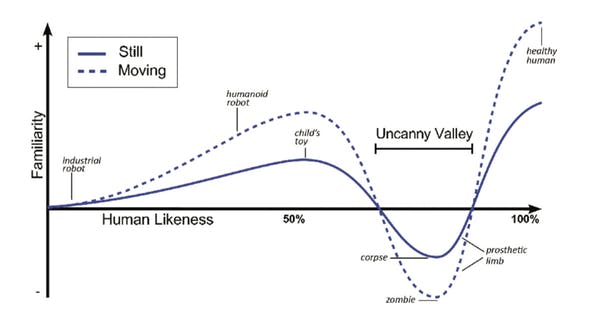Computer generated graphics now enable some pretty amazing visual effects in films. In particular, it has been able to make animations look extremely lifelike. But interestingly, when it comes to depicting humans, there turns out to be a problematic element. As the animation gets more and more lifelike, audiences respond positively, getting more empathetic and engaged, but once it gets pretty close but is still not perfect, audience approval drops sharply and people tend to see the humans as creepy until the animation reaches close to 100% of being lifelike, as shown in this graph. The dip is known as the ‘uncanny valley’.
Moshe Mahler explains the phenomenon and gives examples using film clips.
In the paper, we found that audiences are much more sensitive to distortions in computer-generated faces, even when larger, seemingly more obvious distortions are present on the body. In other words, there’s more room for error when creating computer-generated bodies and a much smaller margin for error when creating computer-generated faces.
This brings us to the uncanny valley. The term refers to the uncomfortable feeling viewers might experience when they see computer-generated faces that “aren’t quite right.”
The term was coined in 1970 by robotics professor Masahiro Mori. Mori hypothesized that as a humanoid becomes more lifelike, an audience’s “familiarity” toward it increases until a point where the humanoid is almost lifelike, but not perfectly lifelike. At this point, subtle imperfections lead to responses of repulsion or rejection.
He says that a similar problem occurs when films digitally ‘de-age’ actors to portray them at a younger age, as in the recent release of The Irishman that de-ages Robert De Niro, Al Pacino, and Joe Pesci.
Filmmakers have realized that you are safer using depictions of humans that are obviously stylized and caricaturized.
This is largely why the ensuing “Toy Story” franchise ended up featuring toys, not humans, as the protagonists.
It also helps to apply performance capture technology on computer-generated characters who aren’t fully human. That’s what James Cameron did in his 2009 blockbuster, “Avatar.”
The film’s Na’vi species are humanlike but remain an alien species. They’re blue. They have large, radiant eyes. The bridge of their nose is wide and stiff, while the tip of their nose is catlike.
Importantly, however, the animated characters of the film still look somewhat like the actors who played them. Sigourney Weaver’s avatar looks very much like Sigourney Weaver, which helps avoid the “retargeting” problem that occurred in “Polar Express.” Audiences don’t expect the alien race to look or move exactly like humans.


What bugs me about this is that it’s not as if they don’t have hours and hours of real film of the three actors from decades ago to the present to serve as a template for ‘de-aging’ them.
I found the digital depictions of Peter Cushing and Carrie Fisher in Stars Wars: Rogue One to be creepy and unsettling.
Now I’m hearing about plans to use the likenesses of deceased actors to star in new live action films, which I will probably boycott partly because watching 2 hours of creepiness would be too much. Also, I don’t really see the point; you will not be watching a new performance of a legendary actor but just some no-name actor wearing a digital mask. Even if they avoid the uncanny valley it just wouldn’t be the same quality of performance. A great actor is more than just how they look.
I think this is largely why Alita: Battle Angel did so poorly in the U.S. -- the first trailer with her oversized eyes twigged a lot of people’s uncanny valley, and while they later redesigned her eyes (made the irises bigger, if I remember correctly) to look less unnatural, the damage was already done.
@ Trickster Goddess
#2
The movie Rogue One just used different actor to play Moff Tarkin and Princess Leia. Did you mean the TV series?
I am skeptical that “uncanny valley” is a thing. It looks like a chart someone just made up that says “bad simulations of humans are unconvincing” -- it’s just bad lip-synch.
colinday -- The movie used different actors but superimposed digital reconstructions of Peter Cushing and Carrie Fisher on top of them instead of not using the characters at all or hiring actors that looked like them.
It’s the same thing they’re going to do with the new James Dean movie that’s being worked on.
https://www.cbc.ca/news/entertainment/canadian-vfx-studio-james-dean-1.5351634
Which is bullshit of course because James Dean isn’t going to be doing any acting in the movie. I don’t know how putting an image of a dead actor over the performance of a living one is going to help with “extreme complex character arcs”.
Oh gods. I just got to the end of that article because there were some stuff I didn’t see the first time I read about this (I’m pretty sure Chris Evans has since looked into locking down restrictions on his image after he dies), and the quotes get worse…
.
@Tabby #6,7
Ugh, that really is revolting, in so many ways
That is weirdly phrased. Usually you use actors to portray characters, not characters to play characters.